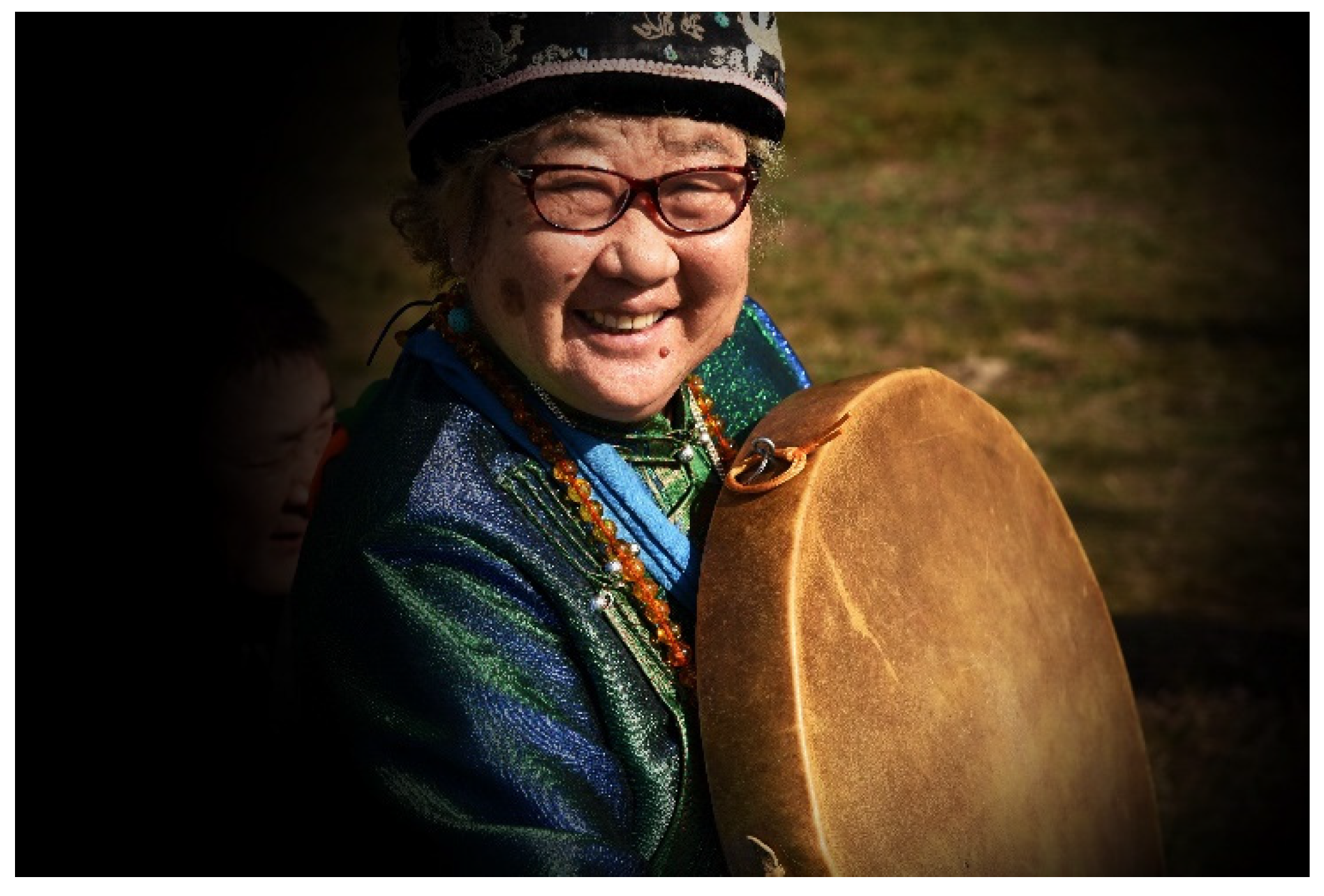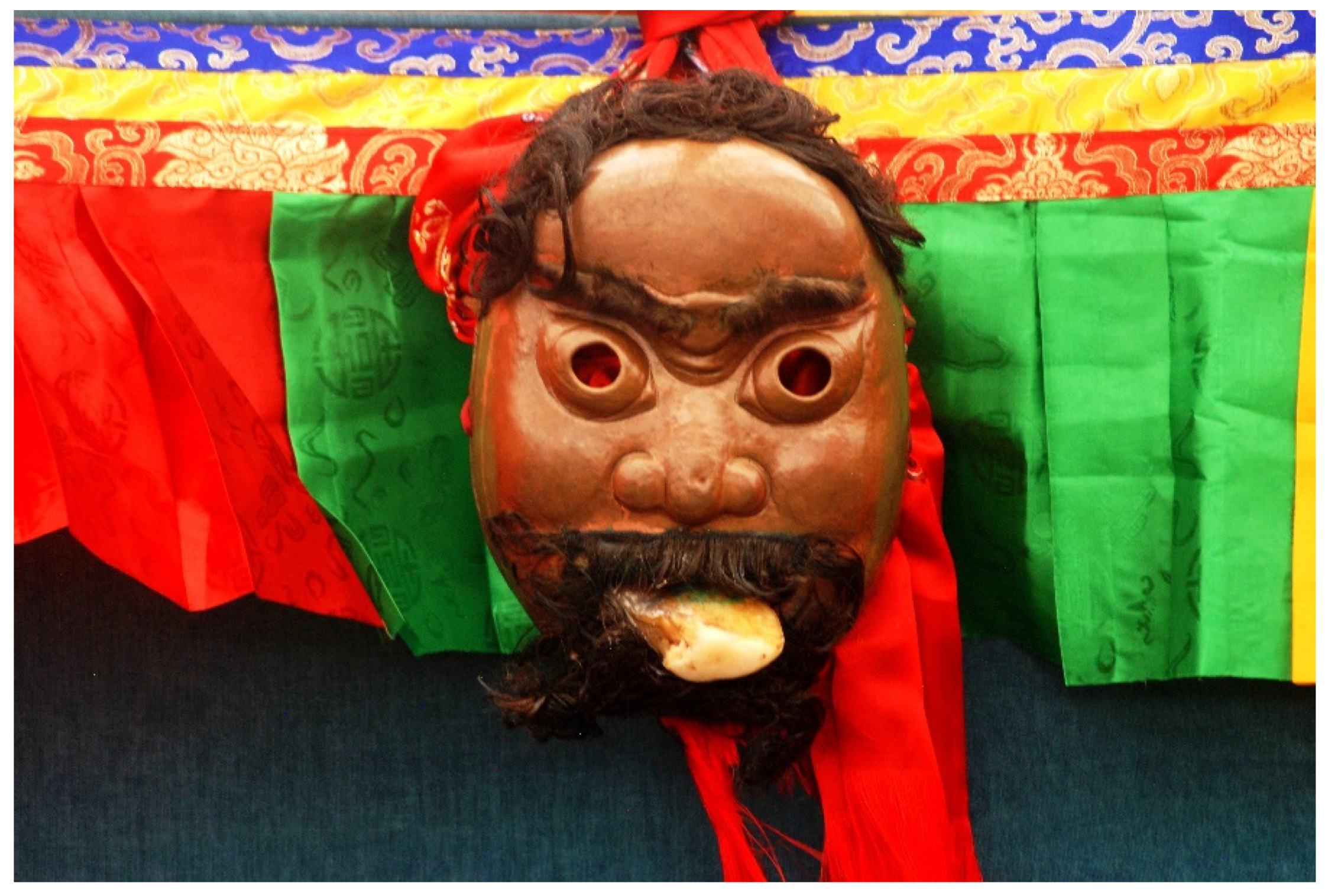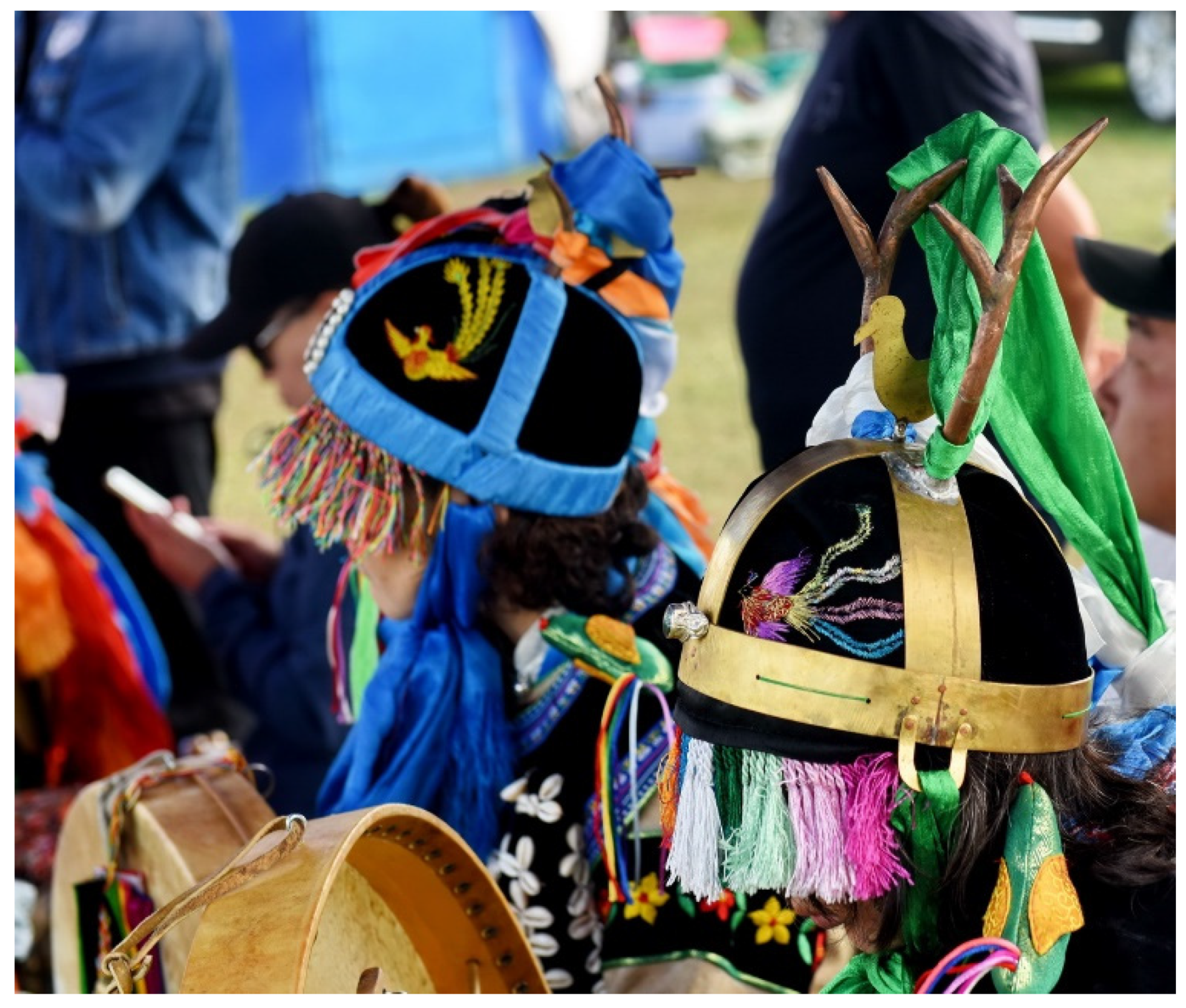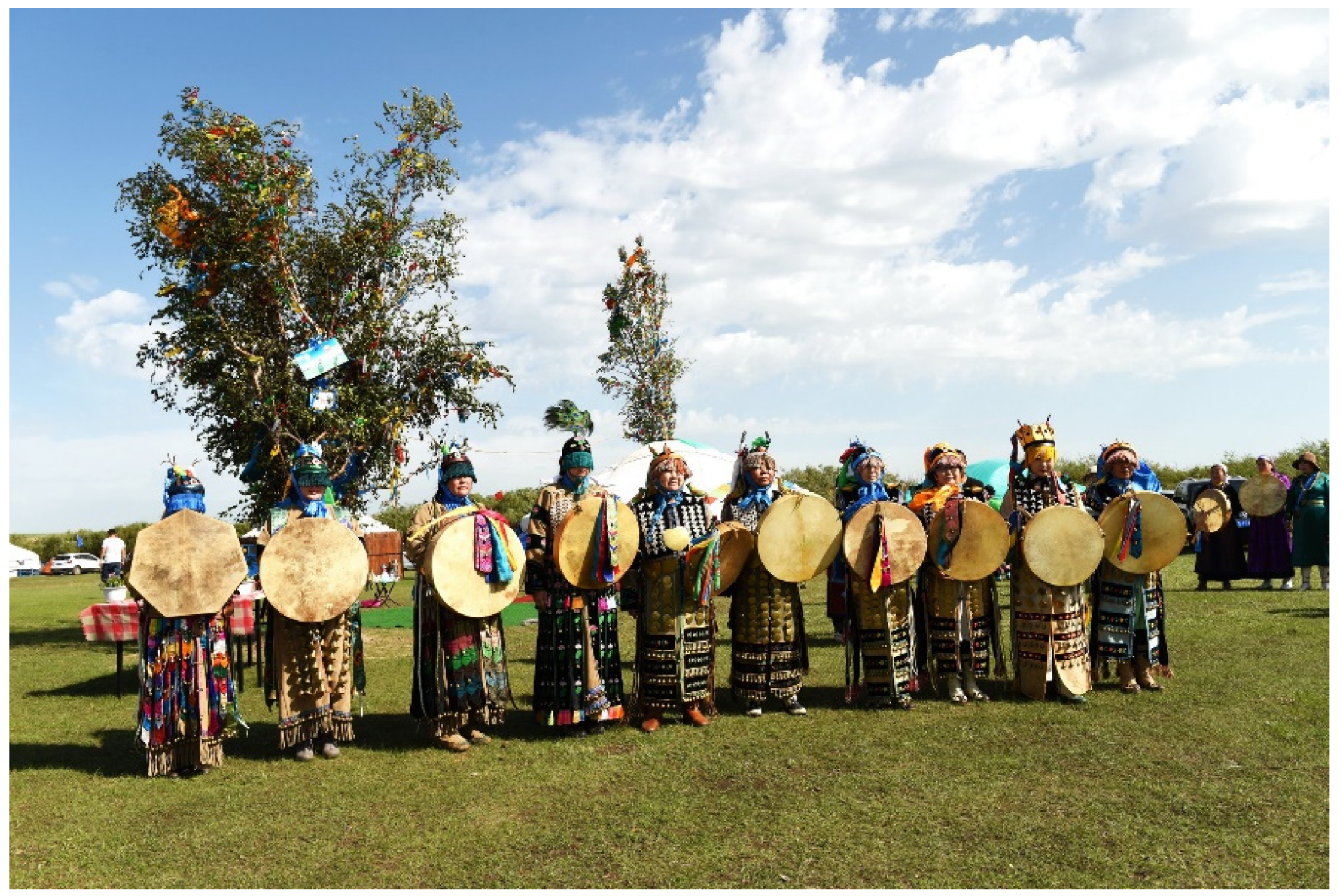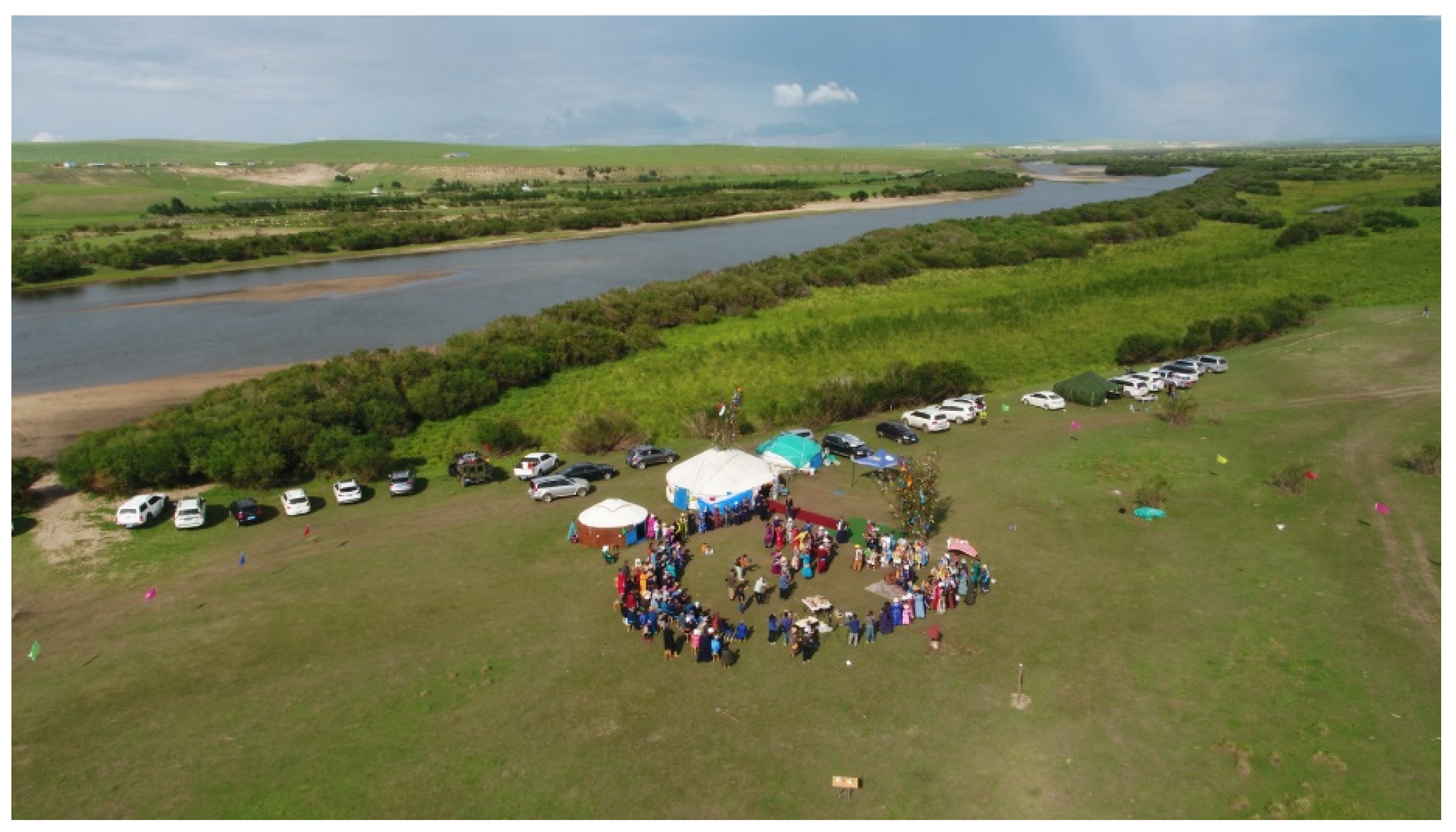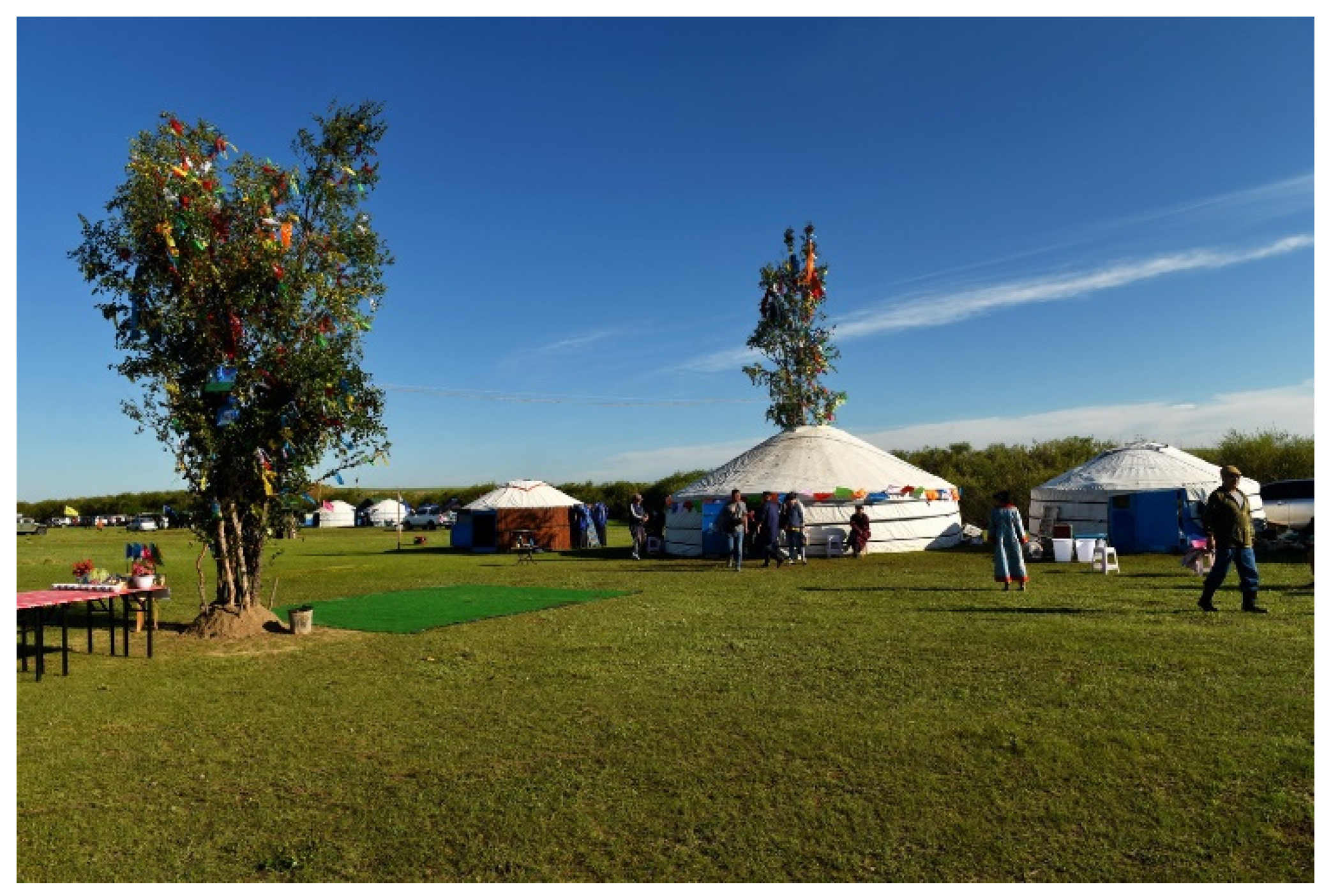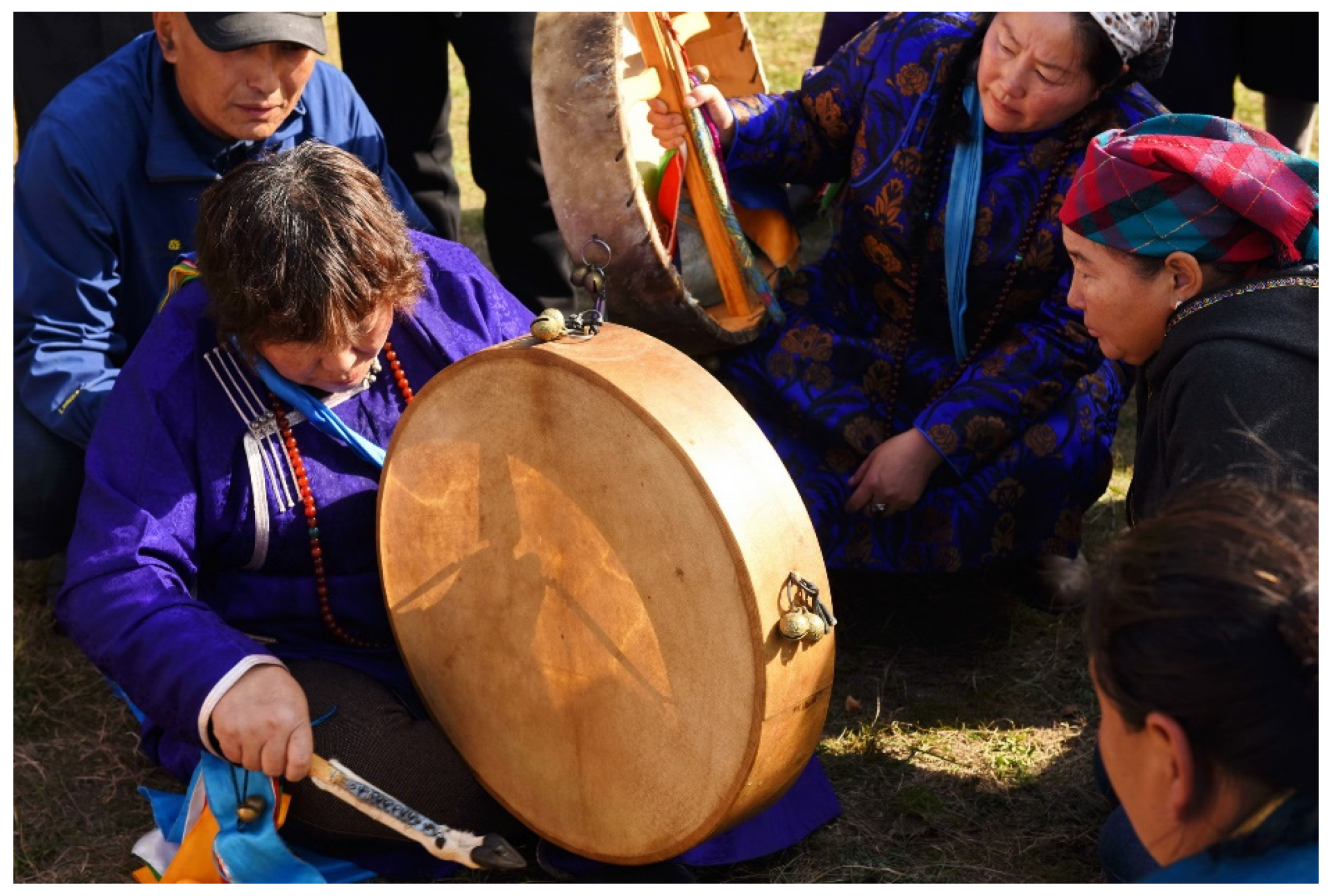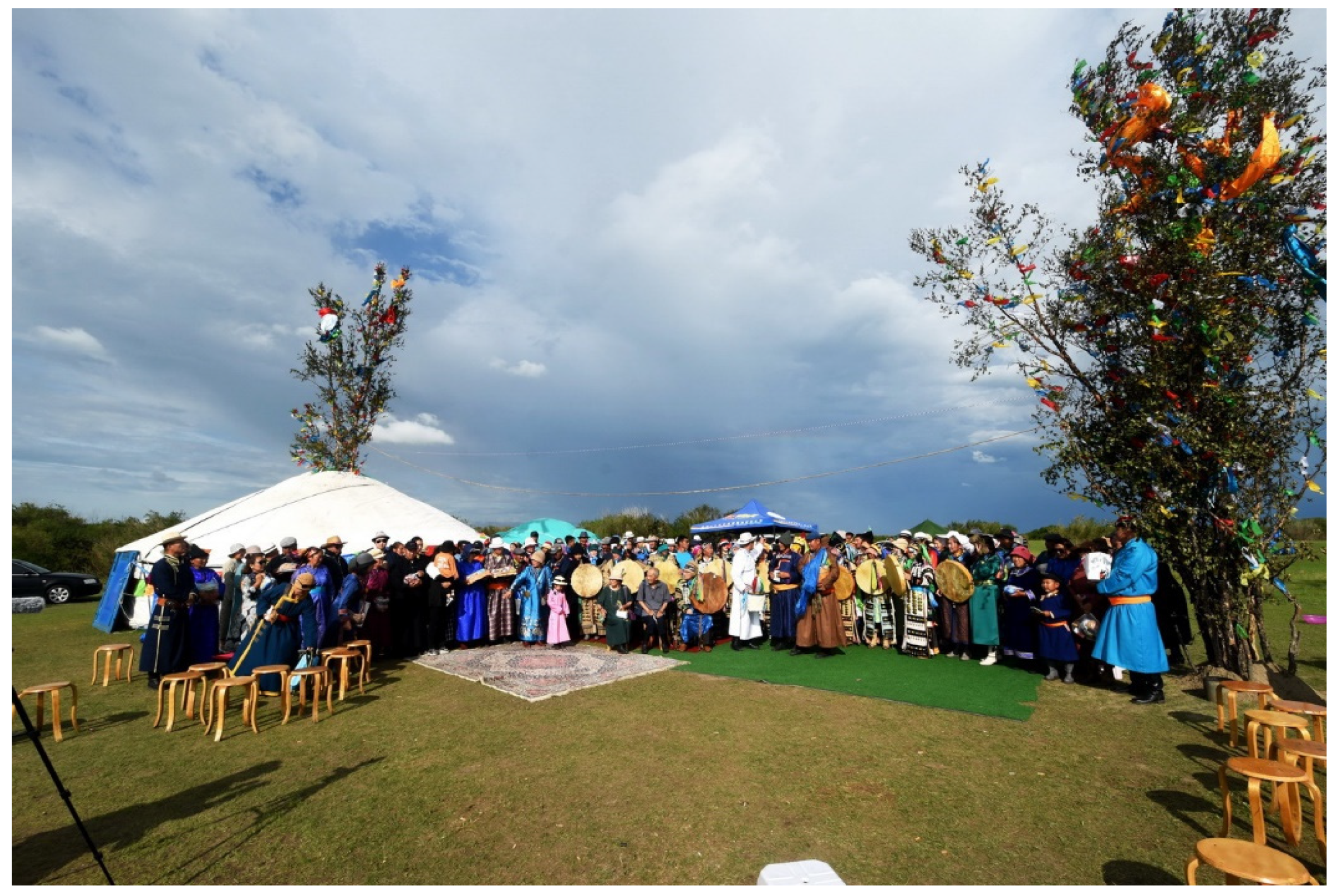2. A Brief History of Daur Shamanism
The Daur immigrated from the Upper and Middle Amur River region to the Naun River (Nenjiang) valley in the 17th century. Today, most of the Daur people live in the Evenki Autonomous Banner (Hailar region) and the Morin Dawa Daur Autonomous Banner in Inner Mongolia, Qiqihar City in Heilongjiang Province, and Tacheng City in Xinjiang (
Zhurongga and Manduertu 1985, pp. 3–4). According to the Chinese census in 2010, there were around 130,000 Daur people in China at that time (
Sa 2019a,
2019b). The Daur patrilineal clan system is thought to have been organized at least several centuries ago. A clan organization is called a “
hala” and branches of
halas are called “
mokons”
2. According to ancient Chinese literature, scholars have discovered that there were around 30
halas and 60
mokons when they were settling in the Upper and Middle Amur River valley (
Ding and Saiyintana 2011, pp. 22–23;
Zhurongga and Manduertu 1985, pp. 187–89). The
hala/mokon system can still be recognized today. When a Daur person introduces himself/herself to me, s/he often starts to let me know which
hala and
mokon s/he (or her/his father) belongs to.
The Daur are best known for their excellent farming skills. Agriculture as their major subsistence began at least 1000 years ago. Traditional Daur subsistence combined farming, hunting, fishing, gathering, and logging (
Batubaoyin 1991, pp. 22–64). Today, agriculture still plays a major role in Daur economics in Morin Dawa. Fruit growing has been developed in the last two decades and has become the local secondary subsistence style (
Dai 2021). However, my research focus in this paper is the Daur of Hailar. The Daur culture in this region encompasses many nomadic elements, since Bargu and Buriat Mongols and Evenki (Solon Evenki and Kahmnigan) pastoralists are also inhabitants on the same Hailar steppe. Many of them are usually bi- or trilingual (
Kara et al. 2009, p. 142).
Shamanism may have been practiced by the Daur as well as other Indigenous groups in North Asia since ancient times. Archaeological research suggests that shamanic practices might be traced back to the Bronze Age in Central and North Asia (
Devlet 2001;
Rozwadowski 2017). The first appearance of the word “shaman” is from a Medieval Chinese documentary book
Sanchao beimeng huibian 三朝北盟会编 (Collection of documents on the treaties with the North during three reigns) compiled by Xu Mengxin of the Song Dynasty (1126–1207). The word shaman appears when the book describes a Jurchen Imperial advisor: “As for the word
shanman, it is the Nuzhen equivalent of (the Chinese) ‘shamaness’ (
wuyu)” (
Kósa 2007, pp. 117–18). The Daur shaman was first documented by Manchu Qing’s book
Heilongjiang waiji (A Local Record of Heilongjiang) written in the early 19th century. He writes, “If a Daur person is sick, (this person) must call a
sama to dance for healing” (
Xiqing 1984, p. 68;
cited by Menghedalai and Amin 2013, p. 205).
Daur shamanism continued to be practiced in the first half of the 20th century but was regarded by the state government as a “primitive” and backward religion, forbidden after 1949 (
Menghedalai and Amin 2013, pp. 244–66). Daur shamans in the Nantun town of Hailar in the 1930–1940s were documented by the Japanese scholar Omachi in his article published in 1944 (
Omachi 1995). The report included the male shaman La (or Lama) who was the great grandfather of a contemporary Daur shaman Siqingua—a key interlocutor in this paper—and the female shaman Huangge
3. Both La shaman and Huangge were renowned for their shamanic skills and were held in high respect beyond the Hailar region
4 (
Ding and Saiyintana 2011;
Humphrey and Onon 1996;
Menghedalai and Amin 2013). In the 1950s and early 1960s, the Chinese state government organized a project to conduct a state-wide field survey of minorities’ social history and cultures. The projects documented surveys of living Daur shamans, although they had abandoned shamanic practices for some years. La shaman even agreed to dress in his shamanic costume and performed his final ritual dance in his lifetime for scholars of the survey project
5 (
Meng 2019, p. 155).
Daur shamanism began to be revived at the end of the 20th century. Siqingua, as the great granddaughter of La shaman, was initiated by a Bargu shaman Hudechulu in 1998 and soon became famous (
Menghedalai and Amin 2013, pp. 475–76). According to my field survey, up to August 2020, Siqingua has held about 15 initiation rituals for her shaman students. These neophytes are all from local ethnic groups, including the Bargu, the Daur, the Buriat, and the Evenki. Two of Siqingua’s students are even from Russia and Mongolia (
Figure 1).
3. Spirits and Images
Pedersen (
2001) has identified two main types of shamanism in North Asia. While the shamanism in Northern North Asia (NNA) focuses on social interactions between humans and animals, SNA shamanism is characterized by inter-human transformations.
Kara et al. (
2009, pp. 147–48) correctly write that a Daur shaman usually “inherited his or her special ability from a shamanic ancestor of the clan who passed on the ability after his or her death. Shamanic abilities were not inherited by each generation—sometimes these would reappear after one or two generations
6”.
In the Daur language, both male and female shamans are called “
yadgan.” However, the Daur of Hailar often use the term “shaman” to describe the
yadgan due to the cultural influence from the local Evenkis (
Sa 2019a, p. 3). There are also other specialists alongside the shaman such as the
bagchi as an assistant to the shaman in rituals or a priest in the public cult, the
otoshi as a healer of children, the
bariechin as a midwife, and the
barshi as a bone-setter. As these specialists are not able to embody spirits, they are not considered to be shamans (
Batubaoyin 1991, pp. 120–22;
Ding and Saiyintana 2011, pp. 43–45;
Humphrey and Onon 1996, p. 30;
Sa 2019a, pp. 3–4;
Zhurongga and Manduertu 1985, pp. 266–67).
Daur
yadgans can be categorized into two types:
hojoor yadgans and
bodi yadgans.
Hojoor is a Daur word meaning male clan ancestral spirits. This is crucial in the study of Daur shamanism because most Daur shamans are
hojoor yadgans who inherit ancestral spirits from their father’s clan (
Ding and Saiyintana 2011, p. 43;
Humphrey and Onon 1996, pp. 188–89;
Sa 2019a, p. 3;
Zhurongga and Manduertu 1985, p. 268). According to
Sa (
2019a, pp. 5–6), the shamanic ability of a
hojoor yadgan is inherited along the patrilineal line but usually not by each generation. An ancestral shaman may pass the ability onto his (her) son or grandson (granddaughter). The word
bodi means external. This indicates that a
bodi yadgan’s ability is from spirits outside of his or her father’s family, sometimes from the maternal lineage. A
hojoor yadgan has one or two ancestor shamans as master spirits and a pool of other spirits (including animal spirits) who follow the ancestral spirits to be tutelary of the shaman’s
hala-mokon (
Sa 2019b).
As in other ethnic groups in SNA, the Daur pantheon includes the great spirit
tengger (God of Heaven); the spirit of land; dragon as the spirit of river; lightning god; fire god;
Bayin Achaa as the spirit of mountain; animals such as the bear, tiger, snake, fox, and bird; and ancestral spirits (
Batubaoyin 1991, p. 123;
Ding and Saiyintana 2011, pp. 78–115;
Humphrey and Onon 1996, pp. 76–118;
Sa 2019a, pp. 4–5). Two words are used to describe spirits in the Daur language:
barkan and
onggor. According to
Sa (
2019a, p. 5), an Indigenous scholar who has an Evenki father and a Daur mother,
barkan denotes “static, imaged spirits, such as portraits and idols,” but
onggor “indicates changing and dynamic spirits.”
Barkan mainly refers to spirits turned from people after their death, and some of them have legendary origins. However,
onggor includes not only ancestral spirits but also animals and spirits of the land and river. As
Kara et al. (
2009, p. 149) have described,
barkan spirits “are only called
onggors by the shaman when they become helping spirits and enter the shaman’s body”. Namely, “spirits of ancestors or spirits of nature can be invoked and incorporated to the shaman’s body in the form of an
onggor”.
Barkan spirits are usually presented by paintings, portraits on wood, or wood carvings as idols. These idols represent legendary ancestors who died in accidents, the clan
hojoor, and animal spirits. Daur people believe that those who died from accidental causes would haunt living humans. Making images for them and giving sacrifices and offerings to them in rituals would avoid misfortunes in human life. Interestingly, a legendary
barkan usually includes an assemblage of idols not only representing the dead ancestor but also animals associated with him (or her) and objects used by this person. The
holieri barkan, for example, are the most popular group of spirit idols invited by all Daur shamans. It is made of 17 categories of spirits with 58 items including anthropomorphic images, zoomorphic images, and objects (such as a gun used to shoot birds). These idols memorize a legend about an Oronqen man who was killed by lightning. After his death, animals around him and objects used by him all transformed into powerful spirits. Most of these idols are made of wood by carving, but two types of them (11 images, all mythological beings) are portraits on cloth. Another spirit assemblage, called
bogol barkan, consists of a group of idols including anthropomorphic spirits such as an officer, a blacksmith, Lama monk, fisherman, hunter, businessman, and
nianniang wives; animals such as a fox, raven, cuckoo, reindeer, lizard, earthworm, dog, and snake; and objects such as a coffin, rock roller, and trees. Additionally, every
hala has a
hojoor barkan who was the earliest ancestor of the clan. During rituals, these images are placed on the altar in the ritual house to accept offering, sacrifices, prayers, and chanting praises (
Ding and Saiyintana 2011, pp. 96–113;
Zhurongga and Manduertu 1985, pp. 244–59). From my observations, spirit images are either made from foil shaped by cutting and attached to cloth, framed paper paintings, or wood carvings which are usually placed in a red wood box (
Figure 2).
A copper mask embellished with hair used by the Daur shaman is called
Abagaldai. According to Humphrey, the
Abagaldai is “the main
barkan of the ritual”, and people put most of the offerings before him (
Humphrey and Onon 1996, p. 242). The
Abagaldai mask represents the spirit of the black bear. It is said that it is the head of all tutelary spirits. Traditionally, its hair, eyebrows, and mustache were made of hair from a bear (
Figure 3) (
Lü and Qiu 2009, pp. 62–64;
Zhurongga and Manduertu 1985, p. 256)
7).
Daur ritual idols reveal an animist ontology in which humans, nonhuman animals, spirits, and objects are intersubjective. Animals and objects have the same divine status as ancestral spirits to share living human sacrifices and respect. It is true that inter-human transformation plays a central role in SNA shamanism as stated by
Pedersen (
2001) and
Humphrey and Onon (
1996). However, nonhumans, things, and other entities as subjects are equally important elements in SNA shamanic ontologies.
Animal and plant images are present on the Daur shaman’s costume. The shamanic dress of the Daurs and Tungus in Manchuruia was documented by Lindgren 90 years ago, featured with antler headdress, streamers, fringes, bronze mirrors, brass bells, iron pendants, cowries, decorated bands, and animal/plant images (
Lindgren 1935). The general style of the shamanic dress has been inherited by shamans among Daurs and Tungus today and exhibits the universe inhabited by various species including both animals and plants. The Daur shaman headdress is adorned with a pair of reindeer antlers with prongs made of iron (prong numbers represent the shaman’s rank). A metal eagle which symbolizes the shaman’s
onggor perches between the two antlers (
Figure 4) (
Ding and Saiyintana 2011, p. 66). Each epaulet of the costume is surmounted by a stuffed cloth bird representing the shaman’s messenger between the spirits and the shaman (the left bird is male and the right is female) (
Ding and Saiyintana 2011, pp. 70–71). Lü and Qiu have documented the specific qualities of Siqingua’s costume. The collar of the costume is decorated with a dragon and phoenix, showing elements from Han Chinese culture. The waistband is depicted with a natural landscape structured with the sun, moon, trees, mountains, a river, and reindeer. Twelve lower streamers are each embroidered with animals from the Chinese calendar, while twelve upper streamers are each embroidered with life-trees called
duwalan by the Daur (
Lü and Qiu 2009, pp. 45–53). Accoding to Odongowa’s (a Daur ethnologist) interpretation,
duwalan connect spirits and human beings and include the species poplar, prickly pear, white birch, willow, pine, and camphor, among others (
Humphrey and Onon 1996, pp. 176–77)
8.
Based on the ontological perspectives of Indigenous cosmologies (
Descola 2013;
Ingold 1998,
2006;
Viveiros de Castro 1998,
2004;
Willerslev 2004), I contend that these carvings, portraits, and embroidery on the Daur shaman’s costume are more than just representations or symbols, materializing relationships between shaman and spirits and, as living beings and social actors, enabling adjusted styles of communication (
Harvey 2018) at the social interface between worlds. We will see in the next section how these images and associated artefacts participate in the construction of the shamanic landscape and function as constituent things to produce relations engaged with living humans, deceased ancestors, and other nonhuman beings.
4. Social Interface and Construction of the Shamanic Landscape
The term “social interface” in this paper indicates the social space where all potential entities from different worlds are gathered to communicate, exchange ideas, and confer on human clan/family problems. Among the Daur together with other ethnic groups in today’s Hulun Buir, shamanic rituals are frequently held throughout the year, especially in the summer season. Participants, from one family to the next, including the elderly and young children, dress up for the ritual occasion. Attending a shamanic ritual in this sense is little different from attending a secular festival. The primary difference is that a secular ceremony only has human participants from the human world, but the shamanic ritual attracts attendees from different worlds, including not only human persons but also nonhuman persons and ancestral persons. To differentiate from secular ceremonies, I call shamanic rituals “ritual ceremonies” in this paper.
Open public sacrificial cults are common among Indigenous peoples in Hulun Buir historically and today, including the
oboo cairn sacrifice
9,
tengger sacrifice, mountain spirit (
Bayin Achaa) sacrifice, and river spirit sacrifice. The sacrificial cow or pig was slaughtered and cooked, and food and drinks as offerings were provided for spirits in rituals. Historically, these cult ceremonies were usually presided over by a clan elder or the
bagchi, both being specialists to pronounce prayers (
Humphrey 1995;
Humphrey and Onon 1996;
Lü and Qiu 2009, pp. 72–82;
Zhurongga and Manduertu 1985, pp. 256–58). In China, shamanism is not recognized as one of the five official religions by the central government, but as a form of folk belief culture. Since the 1980s, the large-scale
oboo sacrifices have been frequently organized by the local authorities to strengthen the political discourse, and shamans’ ritual performances have been regarded as intangible cultural heritage in the Hulun Buir region. They are usually open to all regional residents in spite of ethnic differences. In this way, shamans are seen as important symbols and often invited by local authorities to preside over these
oboo worships.
Oboo cairns have emerged “as powerful symbols and crucial spots for both Indigenous people and political leaders” (
Dumont 2021, pp. 59–60). Worship is accompanied by feasting, sports, games, and other entertainment activities which are used to delight both humans and spirits. Participants expect to acquire “the blessing of the mountain spirit to make use of the land for the reproduction of life” (
Humphrey and Onon 1996, p. 151).
While shamans and other specialists are invited to perform in the authority-organized public sacrifice activities, they never discontinue clan-based rituals in a half-open way. I use the word “half-open” here because these rituals are not open to everyone but only to their
hala-mokon members. The most conventional rituals include the
ominan, the
eelden, the purification, and the initiation. The
ominan is the greatest shamanic ritual in Daur shamanic practices
10. It takes place every three years and lasts three days. Clan members participate in the ritual communally, and all spirits are invited to descend. Aside from the host shaman, a high-level great shaman (
da yadgan) will be invited to be the leader of the ritual. Other shaman students of the great shaman are also present to perform communally (
Figure 5) (
Batubaoyin 1991, pp. 113–17;
Ding and Saiyintana 2011, pp. 61–66;
Humphrey and Onon 1996, pp. 237–50;
Meng 2019, pp. 102–8;
Zhurongga and Manduertu 1985, pp. 262–64). Humphrey rightly says that not only is the
ominan “a shamanic equivalent of the communal sky/mountain cult”, but it is also “a ‘meta-ritual’ containing an overarching summation of
yadgan shamanship as a whole” (
Humphrey and Onon 1996, p. 237). The
eelden takes place every year or every other year. It usually lasts one day, the same as the initiation ritual. Except for the purification held at home on the day marking the beginning of the lunar calendar year, the
ominan,
eelden, and initiation rituals were in the past held either in the shaman’s courtyard or in the wild (
Zhurongga and Manduertu 1985, pp. 262–64). Today, according to my fieldwork data, most ritual locales are chosen to be in the wild, usually on meadowland by a river (
Figure 6).
The ritual space needs to be created carefully under the instruction of the shaman’s hojoor spirits. As mentioned above, Siqingua inherited her shamanic ability from her father’s grandfather, La shaman. She was initiated in 1998 and has held numerous rituals for herself and her students up to now. She reported in an interview at her home in the town of Nantun during the summer of 2019 that before the ritual day, her ancestors (mostly her great grandfather) would appear in her dreams repeatedly to tell her the ritual location she should choose, as well as details of how to build the ritual space and what sacrificial animals and offerings she should prepare.
The creation of the ritual space constitutes a vital part of the Indigenous shamanic knowledge system since it is one of the key elements to ensure the descending of spirits and the success of the ritual. The shaman’s family, relatives, students, and other
hala/mokon members volunteer to work on preparations of the ritual space. On the evening before the ritual day (or days), volunteers would transport all materials including the sacrificial animals and offering items to the site. A Mongolian-style felt house would be raised and fresh birch trees dug from the mountain forest would be prepared. At dawn before the sunrise of the ritual day (or the first ritual day of
ominan), people would erect two birch trees as
tooroo (meaning sacrificial trees) inside the felt house and some
tooroo trees outside, 20 m from the house door. The inner
tooroo at the top of the felt house are connected with the outer
tooroo by a hide rope accompanied by a string woven with seven (or three, five) colored threads. The number of outer
tooroo trees depends on the host shaman’s generation. For example, Siqingua’s daughter Lina, who is also a shaman and has inherited shamanic abilities from her father’s shaman ancestors, hosted her first
ominan in the summer of 2020. As she is the fourteenth-generation shaman in her father’s family, the number of outer
tooroo trees was precisely fourteen (
Figure 7) (See also
Batubaoyin 1991, pp. 113–14;
Ding and Saiyintana 2011, pp. 61–66;
Humphrey and Onon 1996, pp. 237–50;
Kara et al. 2009, pp. 151–52;
Lü and Qiu 2009, pp. 82–101).
Between the two inner trees, three cross bars made of plum wood were tied to represent a spirit ladder in order to enable the spirits to descend. A pair of stuffed cloth snakes (one black, one white) would be tied to the bottom of the trees. Idols and pictures of the shaman’s
barkens would be placed on the inner altar behind the trees. Beside the trees, the shaman’s costume and
Abagaldai mask would be hung. Pictures of the Sun and the Moon as the symbols of
tengger would be hung on the outer trees. Beside the trees, the outer altar would be set up. Volunteers and participants would tie colored ribbons on both the inner
tooroo and outer
tooroo to show their respects to the spirits (also, see Batubaoyin 1991, pp. 113–14; Ding and Saiyintana 2011, pp. 61–66; Humphrey and Onon 1996, pp. 237–250; Kara et al. 2009, pp. 151–52; Lü and Qiu 2009, pp. 82–101). These actions, as described by
Humphrey and Onon (
1996, p. 239), “were recognized by Daurs to be ancient and therefore generally a good thing, even if their urgent aim was not to preserve them so much as to ‘refresh’ the spirits, which were retained mainly in oral forms of memory”.
The creation of the ritual space conducted by the Daur and other ethnic groups as described above is arguably “linked to what we define as sacred landscape both in the human and physical as well as in the other-than-human world” (
Foutiou et al. 2017, p. 7). Human persons, the felt house, artifacts,
tooroo trees,
barken idols, and
onggor spirits constitute a complex relational network encompassing both human and other-than-human levels. All these actors in this network play a role as a subject, filled with agential and affective properties of personhood. Interactions between them are thus intersubjective and interpersonal. In other words, whether humans, artifacts, or noncorporeal beings, they become themselves through interactions with each other. Here, we may recall what Ingold has proposed as a “domain of entanglement” (
Ingold 2006, p. 14), within which “beings of all kinds, more or less person-like or thing-like, continually and reciprocally bring one another into existence” (
Ingold 2006, p. 10).
The shamanic landscape constructed on Hulun Buir grassland brings humans, other-than-humans (including ancestral spirits), and things together into social relations in animist ontologies. Images, artefacts, and other objects such as
tooroo trees and the felt house play vital roles as things in pulling together “flows and relations into various configurations” (
Hodder 2012, p. 8). In his case study of Khanty shamanism,
Jordan (
2001, p. 102) argues that “the ideological premise to shamanism––upheld, reproduced and transformed through socially sanctioned practices” is grounded in materiality. The human creation of the ritual site, in
Hodder’s (
2012, p. 10) terms, actually transforms objects into agentive things, environment into living landscape, space into place, and time into temporality. The Daur Shamanic landscapes thus constitute what
Hodder (
2012, p. 8) has called “heterogeneous mixes,” in which things bring humans, ancestors, and other bodiless beings together. The hide rope between the outer and inner
tooroo on the Daur ritual site, for example, is said to be “the road of the spirits” (
Humphrey and Onon 1996, p. 240;
Sa 2019b, p. 364). According to Daur knowledge, to be effective, the trees’ leaves must be green and alive, enabling
onggors to descend the trees and the rope, and shamans could also connect with
onggor through the trees (see
Kara et al. 2009, p. 152;
Humphrey and Onon 1996, p. 240). In the Daur or Evenki initiation ritual, a hide stirrup would be tied with the rope, and the new shaman must hold the stirrup and run between the house and the outer trees for three rounds in order to connect with
onggor and so renew his or her body. I observed the Evenki shaman Narengerile’s initiation ritual on a riverbank outside Nantun town in September 2020. When the new shaman was running the last round on the way from the outer
tooroo to the house, she suddenly shouted and jumped wildly. With other people’s help, she was able to sit down and so begin drumming and singing. From her chanted words, people knew the ancestor shaman who was occupying her body (
Figure 8). Here, the rope, the stirrup, and the trees are things to bring
onggor and humans together in actualizing direct communications between them. The shamanic landscape as social interface, together with objects as things, produces “a new assemblage of bodily affects” (
Conneller 2004, p. 50), in which live humans, deceased ancestors, nonhumans, and other noncorporeal beings “continually and reciprocally” bring “one another into existence” (
Ingold 2006, p. 10).
In this way, whether barken idols or other artifacts and ritual objects, they all possess features of a person. In other words, they are actual persons and community members “in their own right sharing the same social and technological world” (
Fowler 2004, p. 4). Therefore, each shaman, each ritual participant, and each ancestral spirit are actually a multi-authored product of social relations engaged with constituent things. Here, we may recall
Strathern’s (
1988) concept “dividual”, because images and associated objects are social beings as dividual and partible, linking humans and other-than-human beings (including ancestors) intimately (see
Fowler 2004, pp. 14–17).
5. Ritual Ceremonies and Embodiment of Ancestral Spirits
The greatest clan ritual, the
Ominan, is conducted every three years by Daur shamans for obtaining higher rank and renewing power. It is the best case for us to understand SNA Indigenous shamanism because it is a “meta-ritual” which contains “an overarching summation of yadgan shamanship as a whole” (
Humphrey and Onon 1996, p. 237). The shaman is qualified to wear headwear with three prongs of reindeer antlers on the first
ominan held three years after the initiation ritual. After that, every
ominan will add another three prongs of antlers to the shaman’s headwear. Twelve-pronged antlers mark the highest rank for a Daur shaman. Siqingua became the greatest contemporary Daur shaman with 12 prongs of antlers on her fourth
ominan in 2015 (also see Ding and Saiyintana 2011; Kara et al. 2009; Lü and Qiu 2009).
The date and the locale of the ritual are carefully selected under the instructions of ancestral spirits. Not only do the shaman’s
hala/
mokon members participate in the ritual but so, too, do the people of “neighboring sub-clans having no shaman of their own, and any other non-clan clients of the shaman” (
Humphrey and Onon 1996, p. 239). Additionally, not only the host shaman and the senior shaman but also other shaman students of the senior shaman will attend. In Siqingua’s
ominan ritual, all her students, including the Daur, Tungusic Evenki, and other Mongolic Bargu and Buriat, would be present to perform and invoke their own
hojoor spirits. Every shaman’s clan members from different ethnic groups will follow their own shaman to attend the ritual. Therefore, a contemporary Daur ritual is an important inter-ethnic event. On 1–3 August 2020, Siqingua’s daughter, Lina shaman, performed her first
ominan with her mother as the senior shaman. Ten other students of Siqingua were included in the three-day event. Hundreds of participants from different clans and tribes belonging to different ethnic groups gathered and expected to communicate with ancestors to receive their blessings and guidance for problem solving.
The Daur shaman plays the key role as the body-conduit linking different worlds. However, the meeting between living humans and ancestral spirits together with other noncorporeal beings is the ultimate destination for a successful ritual.
Humphrey and Onon (
1996, p. 184) have listed a Daur
yadgan’s tasks for his or her people in the ritual: to divine the causes of illness and misfortune; to divine the whereabouts of lost animals; to explain dreams; to enliven the spirit-placings people kept at home; to invoke and bargain with spirits; to consecrate sacrificial animals to spirits; to expel or calm spirits attacking people; to exorcize spirits through substitute objects; to retrieve human souls stolen by spirits; to place children under the protection of
tengger or a female spirit called
Ome Niang-Niang; to invoke and propitiate the souls of dead shamans; to cure mental illness and depression; and to restore balance in social life. These diverse tasks exemplify how the shaman functions as a gifted prophet and an extraordinary healer for his or her community. However, it is important to add that all participants, whether shamans, community members, or deceased ancestors, are equally important ritual actors in creating a social relational network. Community members are not just passive elements in the ritual to be healed and helped with problem solving; they bring personal or communal needs and requests to the ritual which make the ritual meaningfully constructed and relationally emergent. During the entering of ancestral spirits into the shaman’s body, the shaman replies to questions from the spirits and asks questions of the spirits and through consultations with the spirits, pursues a social connection with ancestors which continues in their daily life. All these actions confirm that community members and other participants are indispensable constituents to ensure the success of the shamanic ritual. As
Jokic (
2008, p. 36) argues in his analysis of the Buriat initiation ritual, the new shaman’s “relatives present at the ritual are not merely spectators; they are active participants involved in worship, food preparation, and support for the candidate”.
Humphrey and Onon (
1996, p. 261) also emphasize that traditionally, the Daur shaman “was a relational being, who needed other people to give him or her energy and support”. Similarly, ancestral spirits are active elements engaging with the shaman’s invocations and prayers. They are the main characters to divine, judge, and give clear instructions to the shamans and their people. The incarnation of
onggor is thus “an entirely desired, positive, and voluntary act” (
Jokic 2008, p. 40). When the
onggor of La shaman entered Siqingua’s body at the onset of her
ominan held in September 2009, the ancestor shaman told his great-granddaughter exactly “what to do during the ritual” and “what kind of sheep” she should sacrifice to
hojoor barkan and
tengger. Later, when shamans entered the felt house, La shaman entered Siqingua’s body again and told her “about the order of the
ominaan” (
Kara et al. 2009, p. 153). Every time the
onggor entered the shaman’s body, the spirit would call several
mokon members one by one to approach and take advice (
Sa 2019b, p. 363). Ancestral spirits arguably play a leading role in a Daur ritual. Thus, shamans and spirits, shamans and community members, and spirits and community members “depend on each other, rely on each other, produce each other” (
Hodder 2018, p. 91), and all these actors work together to weave a relational network.
Ding and Saiyintana (
2011, pp. 130–31) documented Siqingua’s first
ominan held in the summer of 2004, during which Siqingua was possessed by different spirits seven times over three days. The first possession occurred on the morning of the first day of the ritual, when La shaman told people how to organize the event, including sacrificial details, timings, sacrificial equipment, and offerings. On the third occasion of spirit possession, the spirit was not Siqingua’s ancestor but an ancestor shaman of the other
hala-mokon. The spirit called his tribe’s people to him (or Siqingua shaman), divined for them, and gave instructions on how to avoid future misfortune. According to my observations of Siqingua’s daughter Lina shaman’s
ominan, held in August 2020, after the main sacrifice, all shamans were possessed by their own
onggor spirits and every participant called by his or her ancestor shaman to confer on personal or family issues.
The dialogue between clan members and ancestral spirits goes on through the whole ritual process. The spirit speaks through the shaman while he or she is singing, accompanied by drumming, and the people gathered respond to the spirit in various ways. The spirit may tell stories about himself (or herself), and in return, people may tell of their suffering and ask for help from the spirit (
Humphrey and Onon 1996, p. 240). At the closing ritual of Wo Jufen shaman’s (a student of Siqingua’s) first
ominan held in June 2009, the shaman’s ancestor descended, summarized the whole ritual procedure, gave thanks to all participants, and expressed his appreciation. Finally, the ancestor asked the people if they agreed that the shaman should be upgraded to a higher rank, and all the people shouted “yes” to the spirit (
Ding and Saiyintana 2011, p. 291).
The reciprocal principle is clearly shown between humans and spirits during Daur shamanic rituals. While live humans provide offerings, sacrificial animals, and praise to their ancestors and other spirits, the spirits give people blessings and guide them to avoid illness and misfortune. Usually, on the afternoon of the third day of the
ominan, nine girls and nine boys perform a traditional Daur dance around the outer altar, accompanied by traditional music, to amuse the spirits and the people themselves. A
kuree ritual is performed by shamans and all of the people at the end of the
ominan. Each
yadgan holds one end of a leather thong, and, one by one, people hold the other end of the rope in order to duck under it and escape. It is said that such actions can facilitate spirits’ blessings in order to avoid illness (
Ding and Saiyintana 2011, p. 63;
Humphrey and Onon 1996, pp. 240–41;
Lü and Qiu 2009, p. 100). On the last night of the
ominan, there is a “blood drinking” ritual held in the felt house in darkness, in which people feed spirit idols with calf blood. After this, all of the people gather around the bonfire outside the house to dance and sing in order to amuse both humans and spirits (
Lü and Qiu 2009, pp. 100–1).
To summarize, the Daur shamanic landscape creates a social interface at which various entities gather from different worlds in a sharing space. Various metamorphoses immediately collapse the boundaries between the domains of live humans and deceased ancestors as well as nonhuman spirits. It seems to me that the ritual is in many ways similar to a festival ceremony in which beings of all kinds enjoy food, drink, and music, exchange information, and merge into one social community; however, in the shamanic ritual, the ancestral spirits join the celebration.
6. Ancestors as Active Participants in Daur Social Life
Although the death of a Daur shaman ends his or her biological life, the “inter-human metamorphosis” in the ritual enables his or her social life to continue. Ancestor shamans still actively participate in organizing the social life of their hala-mokon through their communications with their descendants in the ritual. For the Daur and other Indigenous peoples in Hailar, ancestral spirits are still “live” persons living with humans in the same social realm. Although they normally reside in mountains and forests, they are always invited to visit their descendants by the shaman’s invocations and prayers. It is crucial to point out that such inter-human connections between the living and the deceased are always experienced by people in a social rather than ‘religious’ context. Their communications with ancestors through possessed shamans constitute a vital part of Indigenous social acts. As Duna, the Evenki shaman Narengerile’s daughter, who has many years of experience as a servant in shamanic rituals, told me:
I never feel our ancestors are gods we need to worship. They are onggor, but the word onggor is not like the word god in the Chinese language. They are my family members. They do not live with us. They have their own places to live. However, they visit us in the ritual, just like a relative of mine visits my family sometimes. (28 September 2020)
Here, I recall Shirokogoroff’s “safety valve” theory, in which he argues that a Tungus (or Manchu) shaman “acts as a
safety valve and as a special clan officer in charge of the regulation of the psychic equilibrium among the clan members” (
Shirokogoroff 1935, p. 376). A shaman “cannot refuse to assist his clansmen” because he or she bears “a great responsibility” (
Shirokogoroff 1935, p. 380). Regardless of his functionalist bias, Shirokogoroff successfully determines the central role played by the shaman to maintain the cosmological harmony and social balance among North Asian groups. However, taking an ontological approach, I contend that it is the ancestor shamans and the live shamans together rather than only the live shamans who play a role as a safety valve. From the active participation of ancestral spirits through the shaman’s performance, people learn cosmological knowledge, survival strategies, crisis management, conflict resolution skills, ecological intelligence, and traditional wisdom in order to establish community well-being.
One more question is whether the Daur human-ancestor relation can be usefully considered as totemist or animist. Based on
Lévi-Strauss’s (
1964) conceptions of Australian ethnographic data and
Descola’s (
1996,
2013) ontological classification,
Pedersen (
2001, pp. 423–24) sees the human-nonhuman transformation as a reflection of the animist principle in NNA and the “inter-human metamorphosis” as a production of the totemist principle in SNA societies. Such an attempt to distinguish NNA and SNA as two heterogeneous cultural geographic areas has been made in previous scholarship (e.g.,
Hamayon 1994). In my view, it is problematic to elaborate a dualistic model for cultures across an interconnected region, because cultural interactions and relations between NNA and SNA are much more prominent than their distinctions. Shamanism and shamanic cosmologies in North Asia overall have been established on the all-groups-recognized singular principle to deal with human relations with the other social realm, encompassing nonhuman animals, plants, ancestors, and other noncorporeal beings. This singular ontological principle is theorized as animism in
Descola’s (
1996,
2013) approach or perspectivism in
Viveiros de Castro’s (
1998,
2004). Both human-nonhuman and inter-human transformations fit the animist ontology which recognizes interior continuity and exterior discontinuity, because both animal spirits and ancestors are noncorporeal beings, showing dissimilar physicalities between humans and animal/ancestral spirits. To my mind, inter-human perspectivism in SNA is not opposed to extra-human perspectivism. Rather, it should be perceived as the regional version of perspectivism or animism. There is no necessity to borrow the concept of totemism from Australian Aboriginal societies to arbitrarily label the SNA ontologies and pursue a dualistic model between NNA and SNA.
Inter-human metamorphosis is also crucial to Daur self-conceptualization and identity. Through the embodiment of ancestral spirits, shamans today reconstruct clan history and rediscover patrilineal genealogy eroded by the presiding state government following the 1949 legislation. During the Daur shamanic trance, ancestral spirits always lament their personal experience. They often cry out to tell how they took generations to come down to meet people by finding a “seed” shaman (new shaman). For many contemporary Buriats in Russia and Mongolia who lost their family genealogy, they are eager to know who their ancestors are. They often receive answers from the shaman possessed by ancestral spirits (
Jokic 2008;
Shimamura 2004). In the Evenki shaman Narengerile’s initiation ritual, when the last shaman in her father’s line entered her body, her family members learned this ancestor’s life story and that he was buried on a small island in Lake Baikal. After the ritual, shaman Narengerile told me that she is starting to plan a trip to Russia in the near future to look for her ancestor’s grave.
Shamanic landscapes and inter-human metamorphosis among ethnic groups in the Hailar region enable the traditional local, clan-based system to creatively persist in the modern world (
Figure 9). On the one hand, many Indigenous peoples have successfully adapted to the modern social system. On the other, they rely on the underlying clan-based structure to shape their ethnic identities. Although contemporary shamanic rituals are often organized in a supra-ethnic way
11, participants are still centered on their own clan shamans for cross-boundary interactions. Clan solidarity and community cohesion are thus intensified through repeated shamanic rituals.
7. Conclusions
My case study of Daur shamanism in this article suggests that, as stated by
Pedersen (
2001, p. 415), “the realm of the social does not end with human beings.” For the Daur as well as other Indigenous peoples in Hailar, the social realm is constituted by not only human beings but also noncorporeal beings such as nonhuman animal and ancestral spirits, as well as material ‘things’ such as ritual objects. Drawing on the theory of animist ontologies (
Descola 2013;
Ingold 1998,
2006;
Viveiros de Castro 1998,
2004;
Willerslev 2004), I developed a relational model, in which I have examined how shamanic constructions of the landscape create a ‘social interface’ which brings together entities from different worlds for the ongoing negotiation of social relations.
For over a century, studies of shamanism have been centered on the religious paradigm in which beings in other worlds are envisioned as gods or sacred entities whom humans revere and worship (
Eliade 1964). However, my examinations and observations of Daur and other Indigenous shamanic rituals in Northeast China suggest that these other entities are persons, equivalent to human beings. In
Viveiros de Castro’s (
1998, p. 472) words, humanity is the “original common condition” for both humans and other beings. Although ancestors and other spirits are bodiless, they both virtually possess personhood and intentionality. Relations between the living and the deceased and between humans and nonhumans are intersubjective and interpersonal.
Humphrey and Onon (
1996, p. 191) have documented their Daur colleague Urgunge’s opinion: “Spirits were not ‘higher’ than human beings, just different.” Such a perspective corresponds to
Descola’s (
1996,
2013) modality of physical discontinuity.
Inter-human perspectivism represents the regional phenomenon of SNA (
Pedersen 2001). The embodiment of ancestral spirits plays a leading role for communication between beings throughout the whole process of the ritual. On the one hand, ancestral spirits are different from zoomorphic spirits because they are tied to living humans by kin relationships. On the other, the humanity of humans is also shared by ancestral spirits and zoomorphic spirits, indicating that both inter-human and human-nonhuman transformations rest on the same animist principle. According to
Sa (
2019b), the embodiment of both ancestral spirits and animal spirits always takes place in the same ritual. A Daur shaman usually has one or two ancestor
hojoors as master spirits but with the aid of animal spirits, indicating that nonhuman animal spirits also play an indispensable part in SNA shamanism.
The construction of the Daur shamanic landscape creates the social interface which enables direct communications between living humans and their ancestors. The entanglement of social relations and the social dynamics within the ritual space are deeply grounded in materiality. My analyses of Daur rituals have suggested that these ritual artifacts and objects are recognized in terms of body metamorphosis, a multiple, extra body of a human person or other-than-human person (Removed for peer review). Both living humans and deceased ancestors are dividual, partible, and multiply authored persons because they rely on materials to become themselves. They are thus linked together by things in producing and reproducing the social interface (
Fowler 2004). Artifacts and objects themselves are also social agents, active participants in the construction of the shamanic landscape together with humans and noncorporeal beings.
Animist ontologies as a re-theorization of shamanism draw our attention away from the Eliadian narrow definition of the shaman (
Wallis 2013). From my explorations of Daur shamanic ontologies, I have argued that shamanic rituals and sacred landscapes are always linked on both human and other-than-human levels. As stated by
Foutiou et al. (
2017, p. 7), “The physical and non-physical landscapes in shamanisms are deeply interrelated and interconnected and constitute an inseparable unity”. The ancestral spirits are crucial in SNA societies. Through rituals, they are actively involved in almost every aspect of human social life. In this way, both live shamans and ancestor shamans are not only ritual actors but also political actors in ANA Indigenous societies. Since political pressure, resource depletion, the destruction of ecosystems, environmental degradation, and climate change have increasingly weakened sustainable development (
Dumont 2021), the construction of the shamanic landscapes and the embodiment of ancestral spirits are particularly valued in SNA societies.
